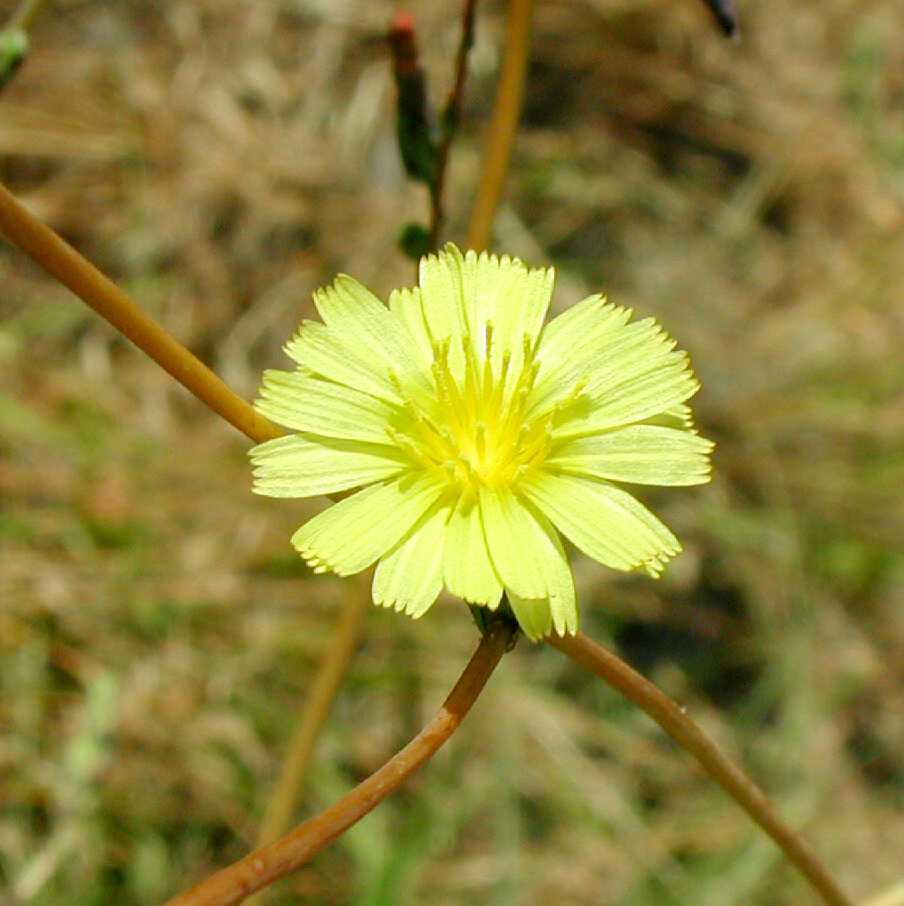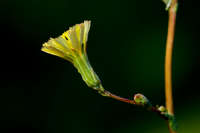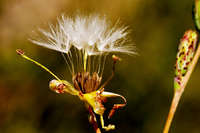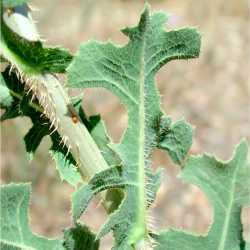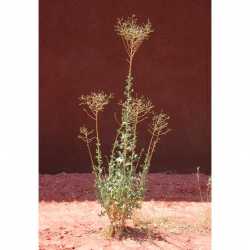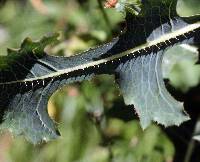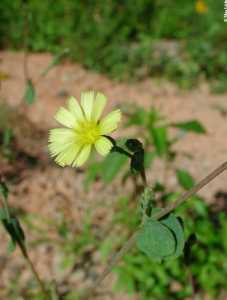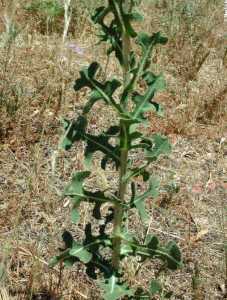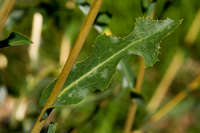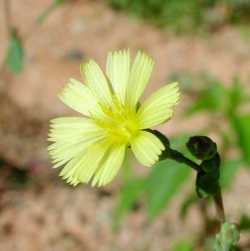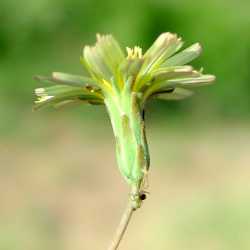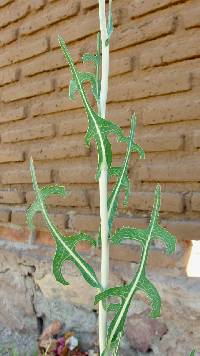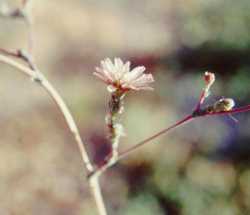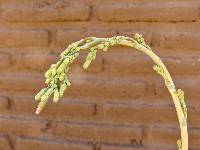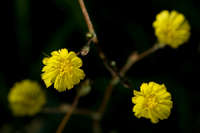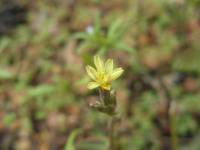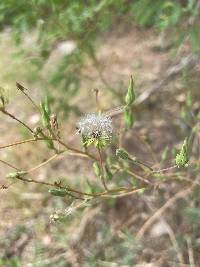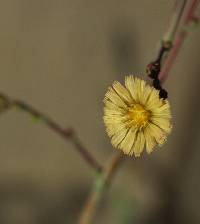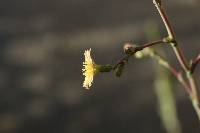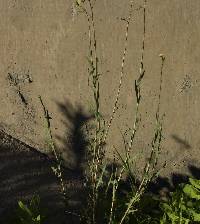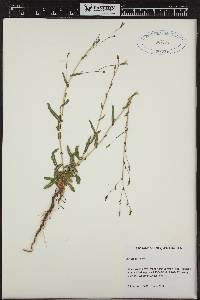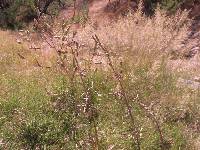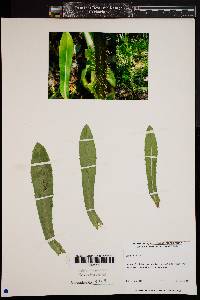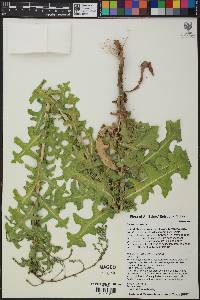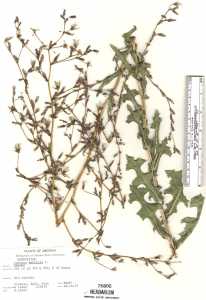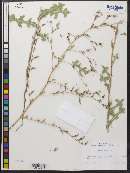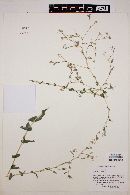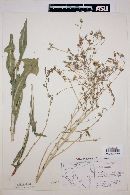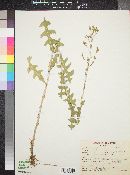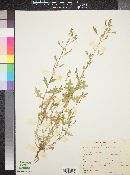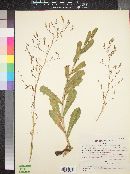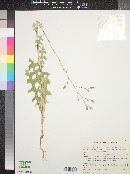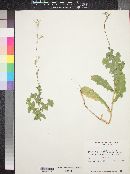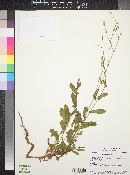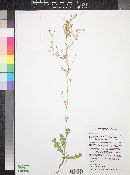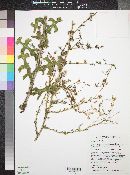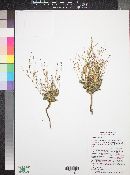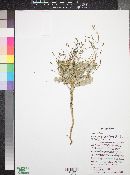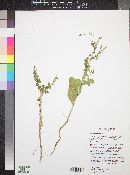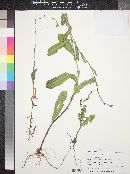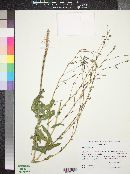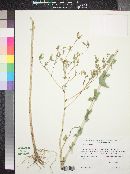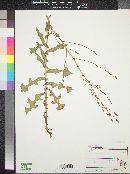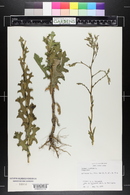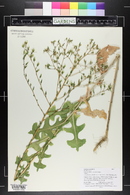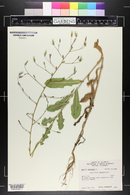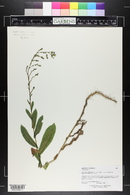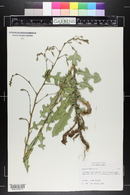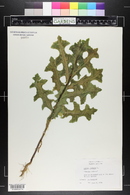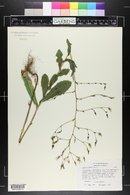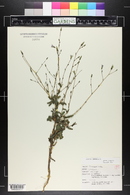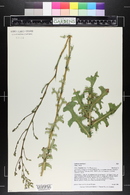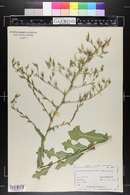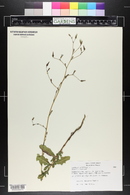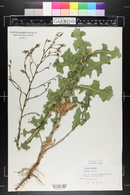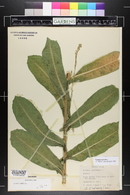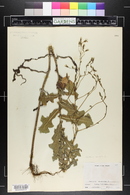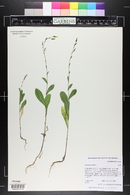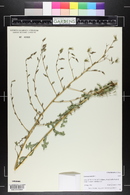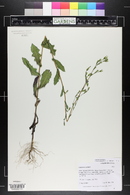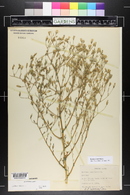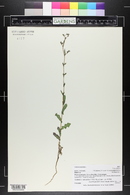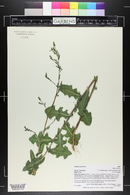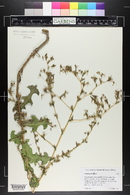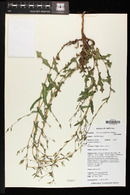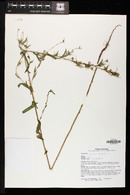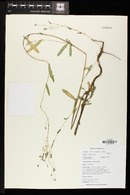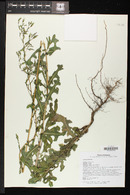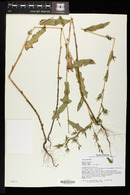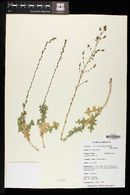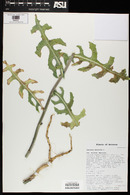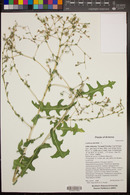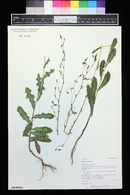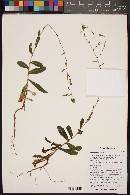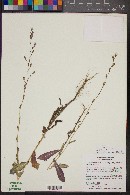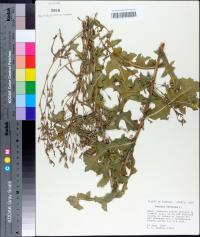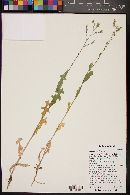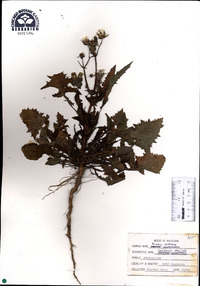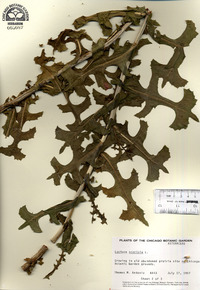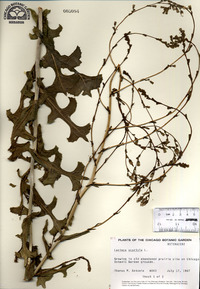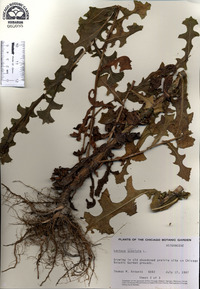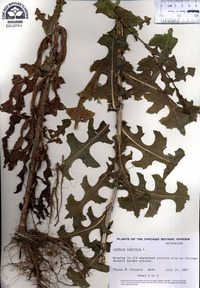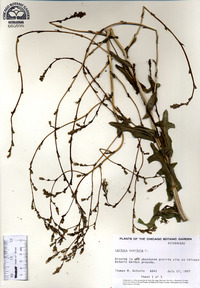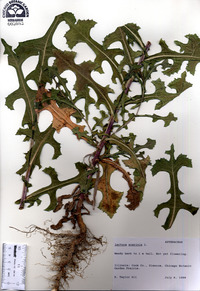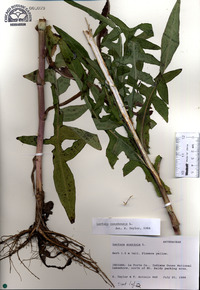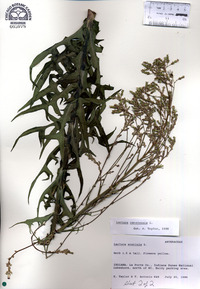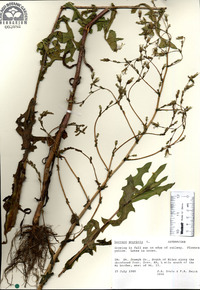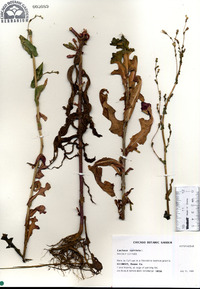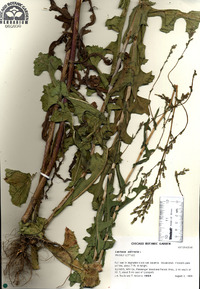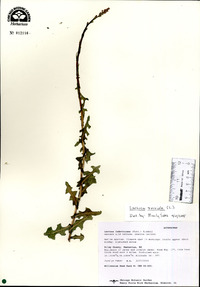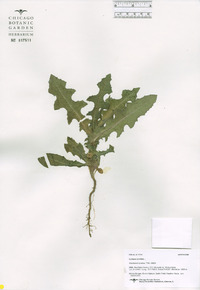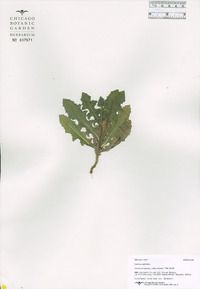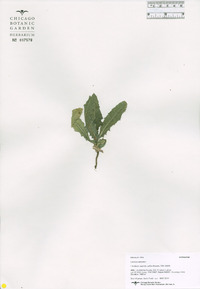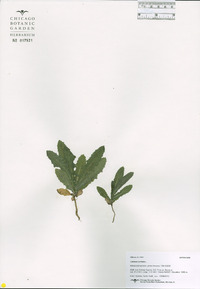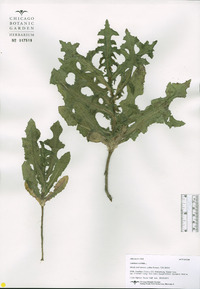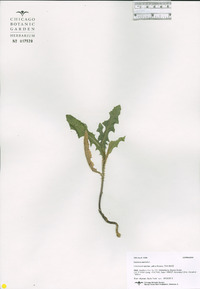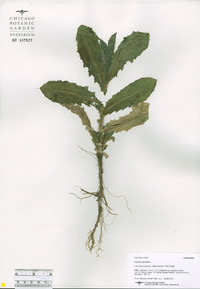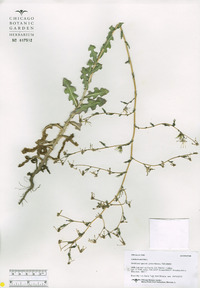Lactuca serriola
|
|
|
|
Family: Asteraceae
Prickly Lettuce, more...compass plant, China lettuce, wild lettuce
[Lactuca scariola L., moreLactuca scariola f. scariola , Lactuca scariola subsp. integrata , Lactuca scariola var. scariola , Lactuca serriola f. integrifolia (Gray) S. D. Prince & R. N. Carter] |
Annuals (perhaps persisting), (15-)30-70(-100+) cm. Leaves on proximal 1/2-3/4 of each stem; blades of undivided cauline leaves usually ± oblong, sometimes ob-ovate to lanceolate, margins denticulate, usually prickly, midribs usually prickly-setose, rarely smooth. Heads in pani-culiform arrays. Involucres 9-10(-12) mm. Phyllaries usually reflexed in fruit. Florets 12-20; corollas yellow, usually deliquescent. Cypselae: bodies pale grayish to tan, ± flattened, oblanceolate, 2.5-3.5 mm, beaks ± filiform, 2.5-4 mm, faces (3-)5-9-nerved; pappi white, (3-)4-5 mm. 2n = 18. Flowering (May-)Jul-Sep(-Oct). Roadsides, disturbed sites; 10-2300 m; introduced; Alta., B.C., Man., N.B., N.S., Ont., P.E.I., Que., Sask.; Ala., Ariz., Ark., Calif., Colo., Conn., Del., D.C., Fla., Ga., Idaho, Ill., Ind., Iowa, Kans., Ky., La., Maine, Md., Mass., Mich., Minn., Miss., Mo., Mont., Nebr., Nev., N.H., N.J., N.Mex., N.Y., N.C., N.Dak., Ohio, Okla., Oreg., Pa., R.I., S.C., S.Dak., Tenn., Tex., Utah, Vt., Va., Wash., W.Va., Wis., Wyo.; Europe; also introduced nearly worldwide. The name Lactuca scariola Linnaeus is evidently illegitimate; it is a superfluous name based on the same type as L. serriola. Plants included here in L. serriola with most leaf blades obovate to lanceolate (not lobed) and lacking prickles on midribs have been called L. scariola subsp. or var. integrata or L. serriola forma integrifolia or L. serriola var. integrata.
FNA 2006, Wiggins 1964, Kearney and Peebles 1969, Heil et al 2015, USDA GRIN Duration: Annual Nativity: Non-Native Lifeform: Forb/Herb General: Annual herb; leafy-stemmed with milky sap. Stems erect, 30-150 cm tall; glabrous for most of length, but prickly at bottom of stem. Leaves: Simple, alternate, sessile, with large prickles on the underside of the midrib and finer prickles on the margins. Blades oblanceolate with pinnately lobed margins. Leaves usually twisted at the base and held in a vertical plane. Milky sap is apparent. Flowers: Numerous (often 100+) small heads arranged in a large panicle or corymb, flowers are all ligulate (ray flowers) and perfect, petals yellow, often drying to blue. Fruits: Cypselae, grayish to tan, oblanceolate and flattened, 2.5-3.5 mm; white pappus. Ecology: Found in fields, waste places, disturbed areas, and roadsides, below 9,000 ft (2743 m). Flowers July-September. Distribution: Native to Africa and Eurasia. Introduced to every continent including all of N. America; all of CAN and every state in the US except AK; south through MEX into S. America. Notes: Distinguished by milky sap, mostly lobed leaves, prickles on stems, margins and midveins of undersides of leaves. Superficially resembles a thistle, but look for the large open panicle inflorescence with many branches full of small (1 cm) cream-yellow flowers. This species is know to hybridize with common garden lettuce, Lactuca sativa. Ethnobotany: Leaves are edible when young and tender. Navajo use steeped plant tea as ceremonial emetic. The sap is said to be soporific. Etymology: Lactuca from lactugo, Latin for -milky,- while serriola means saw-like, referring to the margins of the leaves. Synonyms: Linnaeus scariola Editor: SBuckley 2010, FSCoburn 2015, AHazelton 2015 Leafy-stemmed annual or biennial, 3-15 dm, the stem often prickly below, otherwise glabrous; lvs prickly on the midrib beneath, and more finely prickly-toothed on the margins, otherwise generally glabrous, pinnately lobed or lobeless, commonly twisted at base to stand vertically, sagittate-clasping, oblong or oblong-lanceolate in outline, the upper much reduced; heads numerous in a long, often diffuse infl, with (13-)18-24(-27) light yellow fls, drying blue; invol 10-15 mm in fr; achenes gray or yellowish-gray, the body compressed, 3-4 mm, a third as wide, prominently several-nerved on each face, spinulose or hispidulous above at least marginally, the slender beak about equaling the body, rarely twice as long; 2n=18. A weed in fields and waste places; native of Europe, now naturalized throughout most of the U.S. July-Sept. The common form with lobeless lvs, called var. integrata Gren. & Gordon, may reflect introgression from L. sativa L., cultivated lettuce, with which L. serriola hybridizes freely. (L. scariola) Gleason, Henry A. & Cronquist, Arthur J. 1991. Manual of vascular plants of northeastern United States and adjacent Canada. lxxv + 910 pp. ©The New York Botanical Garden. All rights reserved. Used by permission. From Flora of Indiana (1940) by Charles C. Deam Frequent to abundant throughout the state. It seems to be periodic in its abundance. Some years it is rarely seen and other years it is a common weed. It is found along roadsides and railroads, in waste places in general, and in fallow and cultivated fields. It is usually found in greatest abundance in wheatfields and oatfields. It seems that it appeared in Indiana about 1890, and in a few years it had become an obnoxious weed throughout the state. …… Indiana Coefficient of Conservatism: C = null, non-native Wetland Indicator Status: FACU |
|
|
|

